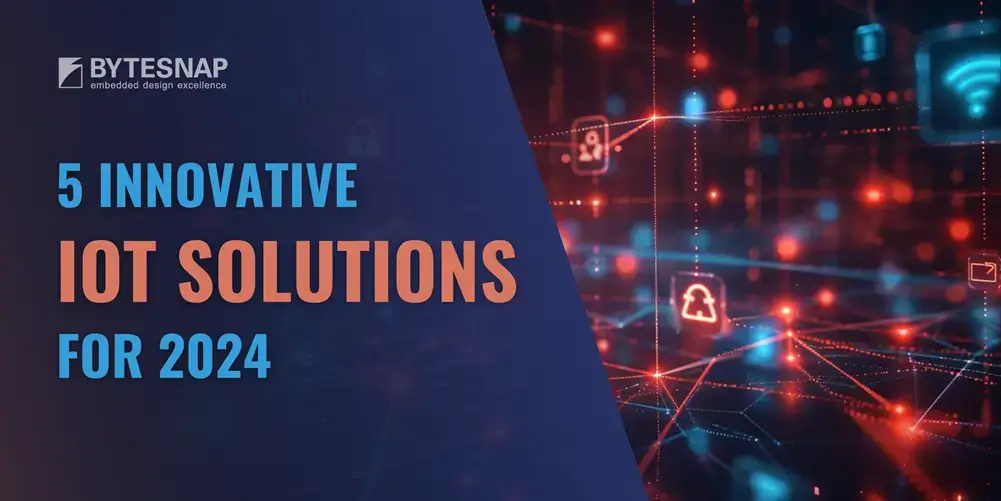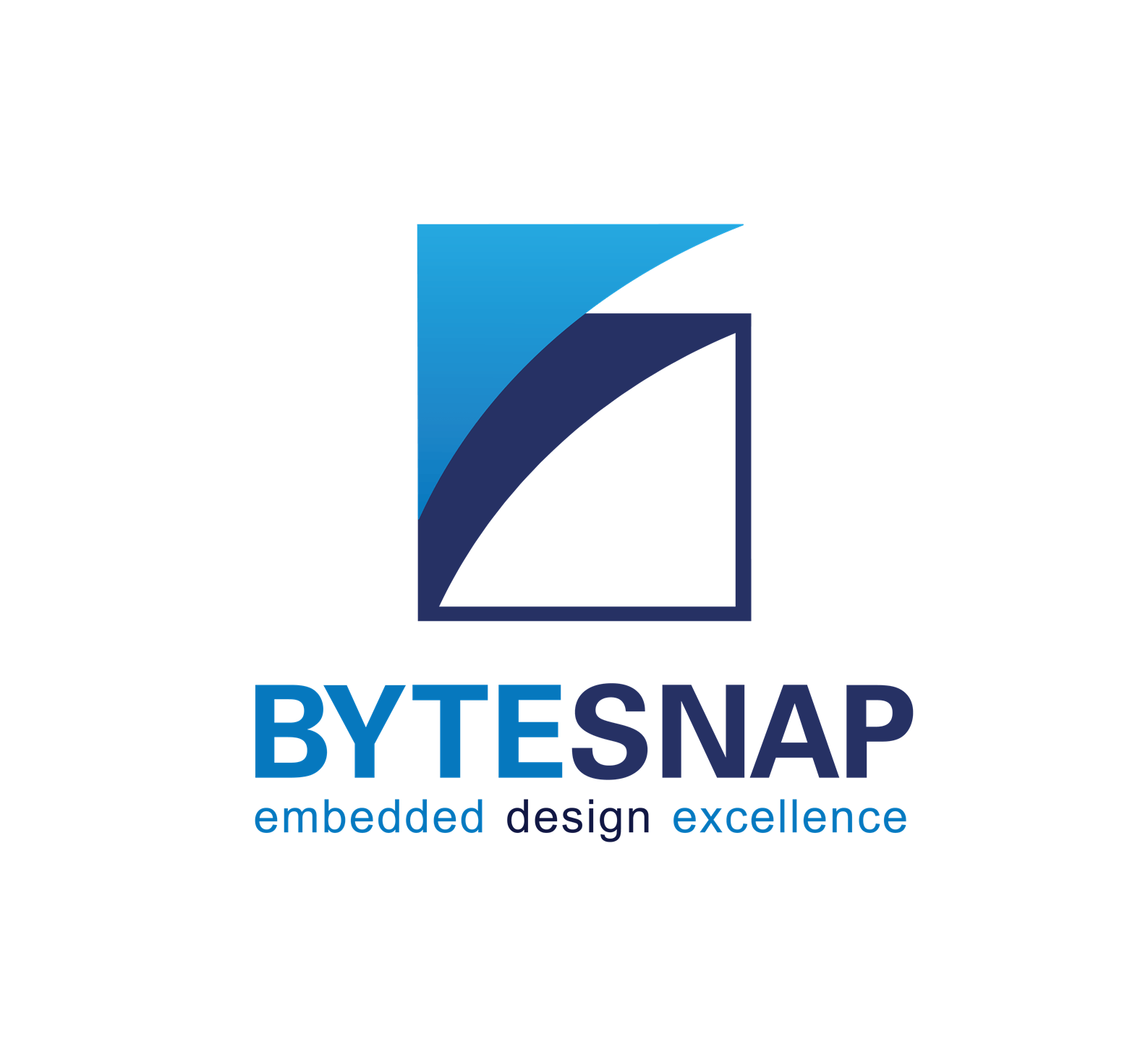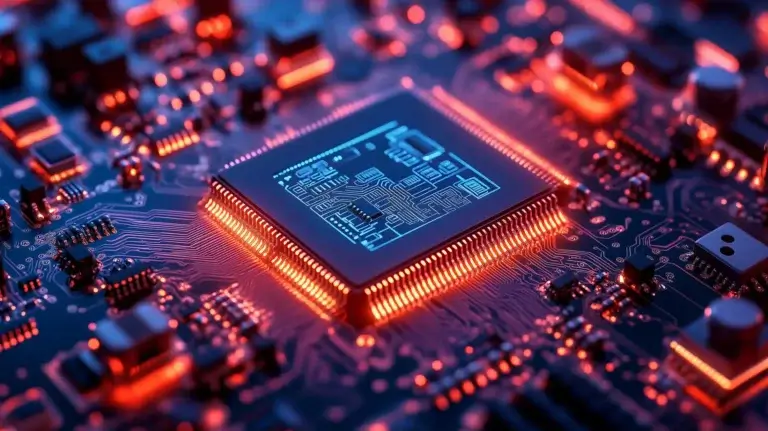As we move further into 2024, the Internet of Things (IoT) continues to evolve, bringing forth innovative solutions that are transforming industries and everyday life. This article explores five cutting-edge IoT technologies that are making significant impacts across various sectors.
In today’s fast-moving technological landscape, IoT solutions are at the forefront of innovation, transforming the way we interact with our surroundings. ByteSnap Design is leading the charge in this revolution, offering deep IoT expertise that’s helping to reshape industries and enhance our daily lives.

The Building Blocks of IoT Success
Successful IoT projects rely on several key components working in harmony. These include:
- Hardware considerations
- Software integration
- Connectivity options
- Robust security measures
ByteSnap’s electronic design services ensure that each of these elements is meticulously crafted to meet the unique demands of your IoT solution.

1. Edge AI for Smart Cities
Edge AI is revolutionising smart city infrastructure by bringing artificial intelligence capabilities directly to IoT devices. This approach enables real-time decision-making without relying on cloud connectivity, reducing latency and enhancing privacy.
Key Technologies:
- TinyML frameworks (e.g., TensorFlow Lite, Edge Impulse)
- Edge computing platforms (e.g., NVIDIA Jetson, Intel OpenVINO)
- Low-power AI chips (e.g., Google’s Edge TPU, Arm’s Ethos-U55)
Real-World Application:
Barcelona has implemented an edge AI-powered traffic management system that’s reshaping urban mobility. Smart cameras equipped with NVIDIA Jetson modules analyse traffic flow in real-time. When congestion is detected, the system automatically adjusts traffic light timings and updates digital signage to redirect traffic. This edge-based approach allows for immediate responses to changing traffic conditions, significantly improving traffic flow and reducing commute times.
The use of Edge AI in smart cities extends beyond traffic management. It’s being applied to enhance public safety through intelligent surveillance systems and optimise energy consumption in smart grids. As cities continue to grow, Edge AI will play a crucial role in making urban environments more efficient, sustainable, and liveable.
2. Blockchain-Enabled IoT Security
As the number of connected devices grows exponentially, so do concerns about data security and integrity. Blockchain technology is emerging as a powerful solution to address these challenges in the IoT ecosystem.
Key Technologies:
- Lightweight blockchain protocols (e.g., IOTA Tangle, Hyperledger Fabric)
- Secure hardware elements (e.g., ARM TrustZone, Intel SGX)
- Decentralised identity solutions (e.g., Sovrin, uPort)
Real-World Application:
Walmart’s partnership with IBM showcases the potential of blockchain in IoT security, particularly in supply chain management.
The retail giant has implemented IBM’s Food Trust platform, which uses Hyperledger Fabric, to revolutionise its food supply chain.
IoT sensors on shipping containers track crucial data such as temperature, humidity, and location. This information is recorded on the blockchain, creating an immutable and transparent record of each product’s journey from farm to store.
The impact of this technology was dramatically demonstrated during a salmonella outbreak in 2018. Walmart was able to trace the source of contaminated produce in seconds rather than days, showcasing the power of blockchain-secured IoT data in ensuring food safety and supply chain transparency.
This application of blockchain in IoT extends beyond retail. It’s being explored in healthcare for secure patient data management, in smart energy grids for peer-to-peer energy trading, and in manufacturing for ensuring the authenticity of parts and products.

3. 5G-Powered Industrial IoT (IIoT)
The advent of 5G networks is set to supercharge Industrial IoT applications, enabling a new era of smart manufacturing and logistics.
Key Technologies:
- 5G New Radio (NR) specifications
- Network slicing
- Mobile edge computing (MEC)
- Time-Sensitive Networking (TSN)
Real-World Application:
The Port of Hamburg in Germany offers a glimpse into the future of 5G-powered IIoT. In collaboration with Deutsche Telekom and Nokia, the port has implemented a comprehensive 5G system that connects various infrastructures, including traffic lights, ships, and cranes.
One of the most impressive applications is the remote control of port machinery. Operators can now control cranes from a central location using high-definition video streams and haptic feedback, all enabled by 5G’s ultra-low latency. This has not only improved operational efficiency but also significantly enhanced worker safety by removing operators from potentially dangerous environments.
Plus, the port uses 5G-connected sensors for real-time monitoring of environmental conditions and infrastructure status. This allows for predictive maintenance and rapid response to potential issues, minimising downtime and maximising throughput.
The implications of 5G in IIoT go far beyond ports. In smart factories, it enables real-time production monitoring and control. In agriculture, it facilitates precision farming techniques.
As 5G networks continue to expand, we can expect to see a proliferation of innovative IIoT applications across various industries.
4. IoT-Enabled Digital Twins
Digital twins represent one of the most exciting developments in IoT technology, creating virtual replicas of physical assets or systems that can be used for monitoring, analysis, and optimisation.
Key Technologies:
- 3D modelling software (e.g., Autodesk Digital Twin)
- IoT platforms (e.g., Microsoft Azure Digital Twins, AWS IoT TwinMaker)
- AI and machine learning for predictive analytics
- Augmented and Virtual Reality (AR/VR) for visualisation
Real-World Application:
Siemens’ digital twin of their Siemens Gamesa wind turbines exemplifies the transformative potential of this technology.
Each physical wind turbine is equipped with hundreds of sensors that continuously feed data to its digital counterpart using Siemens’ Mindsphere IoT platform.
This setup allows Siemens to monitor performance in real-time, predict maintenance needs, and optimise energy production. In one instance, analysis of the digital twin data revealed that adjusting the turbine’s yaw by just a few degrees could significantly increase its power output. When applied across their wind farms, this insight led to substantial increases in energy production.
The applications of digital twins extend far beyond energy production.
In urban planning, digital twins of entire cities can help predict the impact of new infrastructure or policy changes. In healthcare, patient digital twins are being explored for personalised treatment plans.
As IoT sensor technology becomes more sophisticated and data analytics more powerful, we can expect digital twins to play an increasingly important role in how we understand and interact with the physical world.
5. Autonomous IoT Swarms
The concept of autonomous IoT swarms represents a paradigm shift in how we think about networked devices, moving from centralised control to distributed intelligence.
Key Technologies:
- Swarm intelligence algorithms (e.g., Particle Swarm Optimisation)
- Mesh networking protocols (e.g., Zigbee, Thread)
- Collaborative robotics platforms (e.g., Swarm-bots)
- Distributed ledger technologies for consensus
Real-World Application:
In Australia, CSIRO (Commonwealth Scientific and Industrial Research Organisation) has developed an innovative autonomous IoT swarm system called “CSIRObots” for environmental monitoring. This system is being used to survey large areas of the Great Barrier Reef, a task that would be prohibitively time-consuming and expensive using traditional methods.
The CSIRObots are small, low-cost robots equipped with sensors to measure water quality, temperature, and take images of coral health. Using mesh networking, the swarm maintains communication and collaboratively builds a comprehensive map of reef conditions. When one robot detects an area of interest, such as a coral bleaching event, it can signal others to converge and investigate further.
This swarm approach allows for more adaptive and thorough monitoring than traditional methods, providing researchers with unprecedented insights into the health of this vital ecosystem.
The potential applications of autonomous IoT swarms are vast. In agriculture, swarms of ground-based sensors and aerial drones could work together to monitor crop health, detect pests, and optimise irrigation. In disaster response scenarios, swarms of drones could autonomously coordinate to search large areas efficiently, adapting their behaviour based on findings and environmental conditions.
As these technologies continue to develop, we can expect to see autonomous IoT swarms playing increasingly important roles in environmental monitoring, precision agriculture, and disaster response, among other fields.
Best Practices for IoT Product Design
Developing successful IoT products requires adherence to best practices:
- Conduct thorough feasibility studies to identify potential technical and commercial risks early on
- Gather comprehensive requirements to ensure that all stakeholders’ needs are met
- Manage technical risks effectively by developing mitigation strategies for potential issues
- Ensure compliance and certification by meeting regulatory requirements for IoT devices
- Optimise power consumption for wireless devices to reduce energy consumption and extend battery life
ByteSnap’s feasibility study service helps clients navigate these crucial steps, ensuring a smooth path from concept to market-ready product.

Powering the Future of IoT
ByteSnap remains at the forefront of IoT with solutions including:
- LinkRay: load balancer for EV chargers supporting power management for both AC and DC chargers. Available through ByteSnap’s EV charger design company, Versinetic..
- EV Charging Point Controller Boards, OCPP software and EVerest integration: Comprehensive software development and electronic design for electric vehicle charging systems.
These innovations exemplify ByteSnap’s commitment to shaping the future of IoT, particularly in the rapidly growing electric vehicle sector.
Conclusion
These five innovative IoT solutions – Edge AI, Blockchain-enabled security, 5G-powered IIoT, Digital Twins, and Autonomous Swarms – are at the forefront of technological advancement in 2024. As they continue to develop and integrate with other emerging technologies, we can expect to see even more transformative applications that will reshape industries and improve our daily lives. The future of IoT is not just about connected devices, but about creating intelligent, secure, and autonomous systems that can adapt and respond to our world in real-time.
The world of IoT is vast and full of potential. With ByteSnap’s expertise in low power wireless design and comprehensive IoT solutions, your next project is poised for success. From smart home security to electric vehicle charging, ByteSnap is your partner in bringing cutting-edge IoT products to market.
Ready to embark on your IoT journey? Contact ByteSnap Design today for a consultation and take the first step towards realising your IoT vision. Together, we can create connected solutions that shape the future of technology and improve lives around the globe.
References
- Atlam, H. F., & Wills, G. B. (2020). IoT security, privacy, safety and ethics. In Digital Twin Technologies and Smart Cities (pp. 123-149). Springer, Cham.
- Brous, P., Janssen, M., & Herder, P. (2020). The dual effects of the Internet of Things (IoT): A systematic review of the benefits and risks of IoT adoption by organizations. International Journal of Information Management, 51, 101952.
- Deng, S., Zhao, H., Fang, W., Yin, J., Dustdar, S., & Zomaya, A. Y. (2020). Edge intelligence: The confluence of edge computing and artificial intelligence. IEEE Internet of Things Journal, 7(8), 7457-7469.
- Grieves, M., & Vickers, J. (2017). Digital twin: Mitigating unpredictable, undesirable emergent behavior in complex systems. In Transdisciplinary perspectives on complex systems (pp. 85-113). Springer, Cham.
- Liang, W., Li, K. C., Long, J., Kui, X., & Zomaya, A. Y. (2022). An industrial network intrusion detection algorithm based on multifeature data clustering optimization model. IEEE Transactions on Industrial Informatics, 18(3), 2069-2077.
- Mao, Y., You, C., Zhang, J., Huang, K., & Letaief, K. B. (2017). A survey on mobile edge computing: The communication perspective. IEEE Communications Surveys & Tutorials, 19(4), 2322-2358.
- Naha, R. K., Garg, S., Georgakopoulos, D., Jayaraman, P. P., Gao, L., Xiang, Y., & Ranjan, R. (2018). Fog computing: Survey of trends, architectures, requirements, and research directions. IEEE access, 6, 47980-48009.
- Papadakis-Vlachopapadopoulos, K., González-Vidal, A., Devetsikiotis, M., & Skarmeta, A. F. (2022). Collaborative edge computing deployments for smart city services: A survey. IEEE Internet of Things Journal, 9(18), 17344-17370.
- Saad, A., & Faddel, S. (2022). Cybersecurity threats and defence strategies for power systems: A review. IET Smart Grid, 5(1), 1-24.
- Zhang, J., Chen, B., Zhao, Y., Cheng, X., & Hu, F. (2018). Data security and privacy-preserving in edge computing paradigm: Survey and open issues. IEEE Access, 6, 18209-18237.

Founded in 2008, ByteSnap Design is an award-winning embedded systems design consultancy, offering a comprehensive range of services across the electronic product development lifecycle.
A highly skilled team of over 40 hardware and software engineers, our expertise spans several sectors, including IoT, automotive, industrial, medical, and consumer electronics.
The engineering consultants on the ByteSnap Editorial Team share their knowledge and practical tips to help you streamline your product development and accelerate designs to market successfully.
With their deep technical expertise and practical experience, they aim to provide valuable insights and actionable tips to guide you through the complex world of electronic product design and development, to help you bring innovative, reliable, and secure electronic products to market quickly and cost-effectively.




